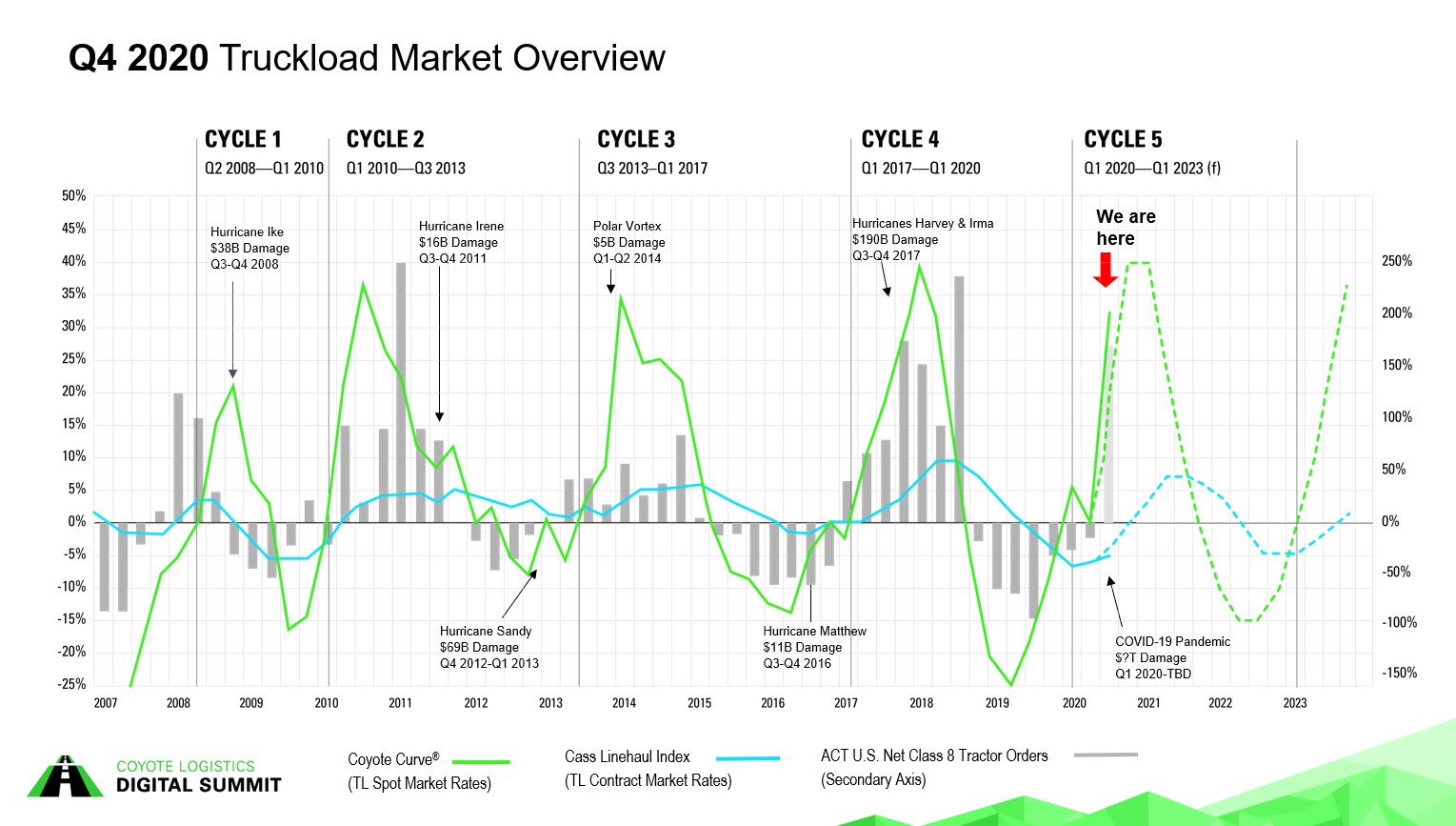15 Things We Learned at the Digital Summit: Key Takeaways from the Virtual Event
On September 30th and October 1st, we hosted thousands of supply chain professionals from around the globe during the Coyote Logistics Digital Summit.
This free, virtual event featured over 35 speakers from leading organizations like CSCMP and UPS. The speakers shared their insights across two curated tracks — one for smaller businesses and one for larger firms — for a total of 17 sessions.
If you missed it live, no problem — you can now watch every session on-demand.
The average Digital Summit attendee watched three sessions, and as much as we’d love for you to watch all 17 sessions, we know you’re busy.
To help bring you some of the insights, we pulled out 15 highlights from several of the more popular sessions.
1. Over the last 31 years, U.S. logistics expense has gone…down?
In the opening keynote session, What Will Global Supply Chains Look Like in a Post-COVID-19 World Rick Blasgen, the President & CEO of The Council for Supply Chain Management Professionals (CSCMP), shed light on just how much more efficient the supply chain has become.
CSCMP has been publishing their Annual State of Logistics® report for 31 years and in that time, the total logistics expense as a percent of U.S. Gross Domestic Product (GDP) has actually decreased — by 33%.
“The definitive cost of logistics in the U.S. was $1.63 trillion, which was ~7.6% of our gross domestic product. That type relationship between cost and GDP is how we understand the impact of logistics.
Interestingly, I went back and just thought, well, how have we been doing in logistics and in supply chain? Since 1988, as a percentage of GDP, logistics expense has gone down about 33%.”
– Rick Blasgen, President & CEO, CSCMP
What drove that change? According to Rick, we’ve redeployed people and become so much better equipped with visibility tools, at managing inventory, at managing transportation and have improved in a whole lot of other areas.
As complicated as modern logistics can seem, it’s worthwhile to remember just how far we’ve come.
Here’s what one Global Account Manager from the world’s largest e-commerce marketplace thought of the session:
“The keynote was excellent. I appreciate the candor of the speakers in their assessment of the challenges we face, and the change companies must make in order to adapt during COVID. Well done!”
2. Democrat or Republican, an Infrastructure Bill Is Coming in 2021
Regardless of who’s in the White House and regardless of which party controls Congress, it’s likely a long-anticipated infrastructure bill (aka highway bill) will be on the docket in 2021.
“Congress kind of has to do it because the current system will run out of money — it has to be reauthorized as goes the phrase — next year.
The highway bill is bread-and-butter, sweet-spot stuff. This is goods movement 101.”
– Tom Jensen, VP of Public Affairs, UPS
In a session on Government Regulations for 2021, UPS policy expert Tom Jensen talked a little more about what could be included from a trucking perspective, including: taxes, HOS rules, motor carrier safety rules, engine standards, electric vehicles, and autonomous trucks.
3. Trucking Market in Q4 & into 2021: It’s Going to Get Tight
Despite all the volatility in the truckload market of late, so far (through Q3 2020), we actually ended up with an inflationary truckload market after all, in-line with our forecast from the beginning of the year.
“We finished Q3 — somewhat ironically, right in-line with our pre-COVID-19 forecast from back in Q4 of 2019.
The truckload market has, once again, behaved in the same cyclical fashion we’ve seen in the past.”
– Chris Pickett, Advisor & Former Chief Strategy Officer, Coyote Logistics
In our Q4 Coyote Curve and Logistics Market update, we learned that spot truckload rates are 35% higher compared to Q3 of last year, as shipper demand is currently outpacing truckload supply.
Expect that to continue with Q4 retail peak season right around the corner.
4. You Don’t Have to Be an Economist to be a Freight Market Expert
The U.S. Truckload market is driven by supply and demand. A solid understanding of these two forces and a few other basic economic indicators is all you need to get started.
Coyote’s VP of Carrier Procurement breaks down Industrial Production, Consumption, the PMI, the Coyote Curve, and more in clear, simple language in Supply & Demand 101: Learning the Basic Economics of the Truckload Market
“Every supply chain and logistics professional should have a basic understanding the core dynamics of the market. The better you understand it, the better you can make long-term strategic plans.”
– Colin Wright, VP of Carrier Procurement, Coyote Logistics
Here’s what one transportation manager thought of the presentation, “Great introduction into the freight market!”
5. Peak Season? Shippers & Carriers Are Already There
Q4 Retail Peak Season is right around the corner, and with the huge ecommerce push, driven by COVID-19 precautions, 2020 is shaping up to be a big one.
While businesses, operated by both shippers and carriers, are dealing with remote work and social distancing restrictions, many have already been operating in peak-like conditions since April.
“When you look at how high volumes were outside of peak, it’s unlike anything we’ve really seen before.
I think that carriers and retail shippers alike are going to be better prepared to go into peak season, having practiced that outside of traditional peak months.”
– Shawn McCloud, VP of Operations, Coyote Logistics
Practice makes perfect, and though there will be many challenges this peak, according to peak experts in the Preparing for Retail Peak Season session, retailers and carriers are prepared to deliver.
6. Don’t Become Paralyzed by the Size of Your Sustainability Goals: Just Do Something
According to our recent research study, 98% of companies have at least one person in charge of sustainability at their company, and 81% of companies are more focused on it today vs. three years ago.
But the scale of improvement that needs to happen across global supply chains to make a meaningful impact on climate change is tremendous, spanning decades.
Though it can feel overwhelming, the key is to just get started. Here’s insight from Coyote’s Head of Europe from the session What Shippers Really Think about Supply Chain Sustainability:
“The biggest risk is not to start because you want to do the most good immediately. Instead, just start doing better…
Also, what we’re seeing is that when you start and people begin to get involved, you have a massive flood of innovative new ideas.”
– Jaap Bruining, EU SVP, Head of Europe, Coyote Logistics
7. Running a Transportation RFP for 2021? Use Your Spot Freight Wisely
In the 7 Steps for Conducting a Better Transportation RFP in 2021 session, two Coyote experts walked viewers through a clear process for hosting better annual logistics bids.
For 2021, based on our position in the truckload market capacity cycle (inflationary), shippers should prepare for capacity and rate volatility by doubling down on their strategic carrier relationships:
“We recommend working with your strategic carriers to get as much primary tender acceptance commitment as possible. If you forecast 100 loads per year shipping in a lane, ask your strategic partner to commit to 120 loads per year.
Try to get insulation against that in inflation, but as the spot market heats up, you should consider giving that same strategic carrier priority access to your spot freight if they’re fulfilling their primary commitments.
Use spot as an incentive to reward the good behavior on that primary during and inflationary market.”
– Jack Gerstner, VP of Coyote Transportation Management (CTM) Operations, Coyote Logistics
8. How to Build a Resilient Supply Chain: Diversification, Flexibility & Data
COVID-19 has tested supply chains big and small. Looking outside the box to add flexibility can help shippers add resiliency to their network.
In this session, Coyote experts from our Flex Solutions, Private Fleet and Transportation Management departments added their insight on what that looks like:
- Diversification in your supply base, both in mode and carrier type
- Flexibility in your procurement
- Flexibility in your operations (loading times, drop trailers, etc.)
- Experimentation with new ideas in your RFP — be willing to try new things
- Using your own fleet’s capacity to generate revenue
- Take a data-driven approach to look beyond the next few months, and plan well into next year
9. Ever Had a Connecting Flight? Then You Know How an LTL Network Operates
Most shippers use less than truckload (LTL) in their supply chains. If you have ever wondered how your freight moves through an LTL carrier’s network, it’s a lot like flying commercial (except instead of people, it’s pallets).
“How LTL works is really the same system that the airlines use — you’re flying from a smaller market into a larger market. If I leave Richmond, VA and I want to get to the West coast, I’m going to fly from here to Atlanta and I’m going to get off the plane in Atlanta.
I’m walking to another door to get on a different plane headed to California with a lot of other people coming from different areas, all trying to get to the West coast. It is exactly how a national hub-and spoke-system works in LTL.”
– Mark Watson, VP of Transportation Intermediaries, Estes Express Lines
In his session, Mark also shared insights about the LTL carrier market, which is much more consolidated than the truckload space:
- $45 billion LTL marketplace
- There are a couple of hundred carriers
- The top five providers handle a little over 50% of the spend
- The top eight providers handle over 80%
- Conversely, the top five truckload carriers only handle about 4% of the overall spend.
10. After a Dip Early in the Year, Intermodal Volume Is Back (with a Vengeance)
In this session featuring intermodal experts, we learned what the rails have been going through this topsy-turvy 2020:
“It’s been an interesting year — you can call it the tale of two cities. For example, our volume was down 20% due to COVID in the first several months of the year.
At first, it was because of the impact overseas, where things were shut down over in China for example, and we weren’t getting any imports, and then again as it moved over here to the U.S.
Now I will tell you, though it’s not true for all of our lines of business, intermodal has come back with a vengeance.
Things have really taken off. A lot of people talk about the record-breaking time period in 2018, and I can tell you that in certain markets — specifically LA outbound — volume levels have been above that.”
– Seana Fairchild, AVP of Intermodal, Union Pacific Railroad
What’s driving the surging intermodal volume? Changes in peoples’ behavior patterns, specifically e-commerce and parcel business, which are huge components of intermodal networks.
11. In a Crisis, Don’t Throw the Baby Out with the Bathwater
COVID-19 has tested every aspect of business, but in our session on managing through a crisis, our Chief People Officer reminded viewers of the importance of sticking to a vision, regardless of circumstance:
“In a time of crisis there’s a knee jerk reaction to throw everything up in the air and say, ‘Oh, all our plans are just going to be put aside. We’re just going to focus on this thing.’
We made a concerted effort to keep a lot of our plans.
We had to make modifications of course, but the stuff that people were excited about, that moves our business and our community, that we regularly do, we made sure to keep up.”
– Jorge Diaz, Chief People Officer, Coyote Logistics
12. Want to Build a Solid Internal Supply Chain Operation? Ask Your Customers
In this session on building an operations program that can deliver better customer service, Coyote Operations leadership discussed Lean principles, how to implement a Continuous Improvement program and training best practices.
It’s important to remember that, at the core, how you build your department should be a reflection of what your customers need, not what you think:
“It’s important to really build out your department around what your customers actually need based on direct insight from them, not just based on what we think they value.
The top five things that our customers value has ultimately dictated what our people focus on.”
– Tricia Dell, SVP of Operations, Coyote Logistics
Though it seems obvious, it’s a common oversight that is the crucial difference between you being able to deliver a superior customer experience or not.
13. You Know Your Business Needs to Invest in Supply Chain — Does Your CEO?
In Break the Chain: Why CPG Supply Chains Need to Transform into Supply Networks, supply chain thought leaders previewed an upcoming co-authored paper and discussed the importance of evolving the function so it can compete in the future.
“The time is now to make the shift. If you don’t make this pivot, [supply chain] is going to be holding growth hostage. You have to have that agility and that insight to deliver on your consumers’ needs.
Right now, your linear architect and supply chains aren’t going to be able to meet the growth of your organization.”
– Chris McDivitt, Managing Director, Accenture
To get this done, it can’t just be the Chief Supply Chain Officer’s idea.
Every business unit has to have a clear understanding of what the supply chain does, how it impacts the business and what it takes to evolve to keep up with shipping in the age of ecommerce.
“If you’re going to change the course of a corporation, and how you operate as a business, you need to be able to explain it. It’s about cross-functional collaboration.
It can’t just be siloed within the supply chain group. It has to be able to be explained to the sales group.
It has to be able to be explained to the CEO. It has to make sense to the CFO that’s going to be funding these larger investments.”
– Tom Madrecki, VP of Supply Chain, Consumer Brands Association
14. COVID-19 Is Super-Charging Digital Adoption Across Supply Chains
Regardless of size, shippers and carriers are all looking to find ways to alleviate themselves of routine, low value, daily tasks.
Using digital solutions to do so has been a consistent trend over the past several years, but the pandemic has dramatically increased the rate of adoption. As they say, necessity is the mother of invention:
“You’re going to see more and more questioning of traditional practices.
For instance, the electronic BOL implementation. It’s not that it’s new, but COVID is really forcing people’s hand into a lot of these new technologies and adopt them a lot quicker.”
– Sean Gill, Director of Shipper Technology, Coyote Logistics
In this session highlighting some of Coyote’s digital solutions, panelists discussed how — no matter what you invest in — technology has to provide value back to your organization.
Buying and setting up new platforms is getting easier, but ensuring you get the insights, value and return from them still requires people (perhaps with new skills) to make sure the technology is working for you rather than creating more work.
Sign-up or log-in to CoyoteGO® for on-demand quoting, booking, tracking and billing.
15. Marketing + Supply Chain is the Key to a Brand’s Success
When you ask most business professionals to complete the phrase, “______ and marketing” most will respond “sales.” In fact, supply chain plays every bit as important of a role in upholding your brand:
“The first connection to your company’s brand promise is the supply chain delivering that promise of quality in production, quality in raw materials, quality in sourcing and quality in distribution.”
– Maria Rey-Marston, Managing Director, Accenture
In this session, Maria, a supply chain expert, and Coyote’s Chief Marketing Officer discussed the intersection of these two business functions, why marketing will be ultimately ineffective without a customer-centric supply chain, and how to explain all of that to your C-suite.
Want More Insights? Watch Any Session On-Demand (for Free)
We learned a lot during our virtual event — we hope you did too.
From the future of supply chain for enterprise shippers, to 101, how-to sessions for small businesses, there is something for every logistics professional.
If you enjoyed these insights, view more sessions from the Coyote Logistics Digital Summit now.





 “The definitive cost of logistics in the U.S. was $1.63 trillion, which was ~7.6% of our gross domestic product. That type relationship between cost and GDP is how we understand the impact of logistics.
“The definitive cost of logistics in the U.S. was $1.63 trillion, which was ~7.6% of our gross domestic product. That type relationship between cost and GDP is how we understand the impact of logistics. “Congress kind of has to do it because the current system will run out of money — it has to be reauthorized as goes the phrase — next year.
“Congress kind of has to do it because the current system will run out of money — it has to be reauthorized as goes the phrase — next year.
 “When you look at how high volumes were outside of peak, it’s unlike anything we’ve really seen before.
“When you look at how high volumes were outside of peak, it’s unlike anything we’ve really seen before. “The biggest risk is not to start because you want to do the most good immediately. Instead, just start doing better…
“The biggest risk is not to start because you want to do the most good immediately. Instead, just start doing better… “We recommend working with your strategic carriers to get as much primary tender acceptance commitment as possible. If you forecast 100 loads per year shipping in a lane, ask your strategic partner to commit to 120 loads per year.
“We recommend working with your strategic carriers to get as much primary tender acceptance commitment as possible. If you forecast 100 loads per year shipping in a lane, ask your strategic partner to commit to 120 loads per year. “How LTL works is really the same system that the airlines use — you’re flying from a smaller market into a larger market. If I leave Richmond, VA and I want to get to the West coast, I’m going to fly from here to Atlanta and I’m going to get off the plane in Atlanta.
“How LTL works is really the same system that the airlines use — you’re flying from a smaller market into a larger market. If I leave Richmond, VA and I want to get to the West coast, I’m going to fly from here to Atlanta and I’m going to get off the plane in Atlanta.  “It’s been an interesting year — you can call it the tale of two cities. For example, our volume was down 20% due to COVID in the first several months of the year.
“It’s been an interesting year — you can call it the tale of two cities. For example, our volume was down 20% due to COVID in the first several months of the year. “In a time of crisis there’s a knee jerk reaction to throw everything up in the air and say, ‘Oh, all our plans are just going to be put aside. We’re just going to focus on this thing.’
“In a time of crisis there’s a knee jerk reaction to throw everything up in the air and say, ‘Oh, all our plans are just going to be put aside. We’re just going to focus on this thing.’ “It’s important to really build out your department around what your customers actually need based on direct insight from them, not just based on what we think they value.
“It’s important to really build out your department around what your customers actually need based on direct insight from them, not just based on what we think they value. “The time is now to make the shift. If you don’t make this pivot, [supply chain] is going to be holding growth hostage. You have to have that agility and that insight to deliver on your consumers’ needs.
“The time is now to make the shift. If you don’t make this pivot, [supply chain] is going to be holding growth hostage. You have to have that agility and that insight to deliver on your consumers’ needs. “If you’re going to change the course of a corporation, and how you operate as a business, you need to be able to explain it. It’s about cross-functional collaboration.
“If you’re going to change the course of a corporation, and how you operate as a business, you need to be able to explain it. It’s about cross-functional collaboration. “You’re going to see more and more questioning of traditional practices.
“You’re going to see more and more questioning of traditional practices. “The first connection to your company’s brand promise is the supply chain delivering that promise of quality in production, quality in raw materials, quality in sourcing and quality in distribution.”
“The first connection to your company’s brand promise is the supply chain delivering that promise of quality in production, quality in raw materials, quality in sourcing and quality in distribution.”